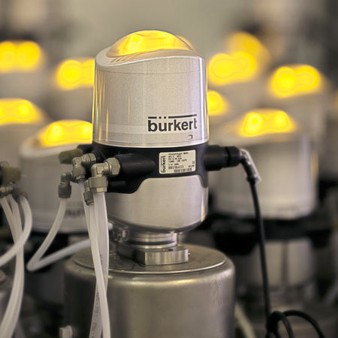 Burkert Valves > Burkert Process Valves that can ‘think’ for themselves
Burkert Valves > Burkert Process Valves that can ‘think’ for themselves
As the control of process valves has become more complicated Burkert have a solution for this problem and have released several innovative intelligent field control devices.
The typical trends in factory automation are leading to increasingly precise control in addition to information being collected at device level. Improved control has led the way for continuous processes, decreased waste, increased hygiene and greater efficiency.
Nevertheless, in a few applications the focus is now on the valve, therefore increasing intelligent and robust field control devices and are permitting valves to communicate with each other and work independently to an growing detailed set of procedures and parameters.
When will centralised control be desirable and just how can de-centralised control be used to enhance process systems?
Burkert automated process valves, based on their size and style may either be ‘piloted’ for example a pressurised air supply or pressure from the medium being controlled is utilized to actuate the valve, or an external actuator can be used (normally an electric ball screw or pneumatic/hydraulic cylinder on bigger valves), or a electric solenoid valve is used. These products are normally connected to a PLC or another electric controller, one that works on a software program or routine and operation of the process valves in synchronisation with the preferred pressure, flow and mixing requirement of the fluid being controlled. In case a compressed air supply is needed, then piloting the valves could be the correct option, additionally there are a few options available for sale to connect substantial numbers of pneumatic control air lines to a control valve manifold block inside a sanitary environment.
To illustrate Burkert’s brand new Airline Quick interface that provides a dependable, small and time-saving solution for direct mounting of valve islands and automation equipment into a stainless steel control cabinet for hygienic process actuation in the food, beverage or pharmaceutical industries.
When connecting larger quantities of process valves, which are generally necessary in high densities for continuous process applications,- usually supplying fluids for instance, ingredients or for CIP processes in confectionary production- then a distributed control method might be advantageous. Using fieldbus protocols such as ASi, Profibus and DeviceNet permits individual valves to be connected simply using a couple of cables.
There's an additional solution, again pioneered by Burkert that enables process valves originating from a wide variety of manufacturers to be controlled centrally, or given a level of independence. Burkert Type 8681 control head provides the main benefit of universal fitment onto third-party hygienic valves: single seat valves, double seat, mix proof as well as quarter turn ball and butterfly valves which have linear stainless steel actuators. Burkert 8681 works with an entire selection of field- bus communication networks, and it is encased inside a strong enclosure that's rated up to IP67 allowing it to be washed down and cleaned carefully. For the last layer of distributed control many process valve automation applications can now dispense completely with the control cabinet providing true process automation right down to valve level. Burkert type 8793 controllers are essentially created to reduce costs in processing applications by permitting a systems engineer to replace a complete control cabinet with a single neat controller that has a built-in backlit display and keypad.
The expenses of individual enclosure rack mounted plc, I/O, cabling, power supply, HMI etc can successfully get replaced with a single little control unit which could be mounted perhaps on or very close to the process valve. The important thing to finding the most effective option is through the analysis of every single part of the plant or installation. In this way, the question of where plant intelligence should rest can be answered. For instance will the nature of the application need centralised control interfacing to non-intelligent nodes, or will the physical size of the system signify that the control will have to be decentralised- using a fieldbus system and intelligent valves and actuators, or could smaller machines or areas be simply controlled by a single localised but powerful process controller- the solution could be a combination of all of the options, however the advantage today is the fact that you'll find new and innovative solutions accessible for each.
For more information on the Smart Burkert Valves or any of the range of Burkert valves contact us today at Electroquip.
